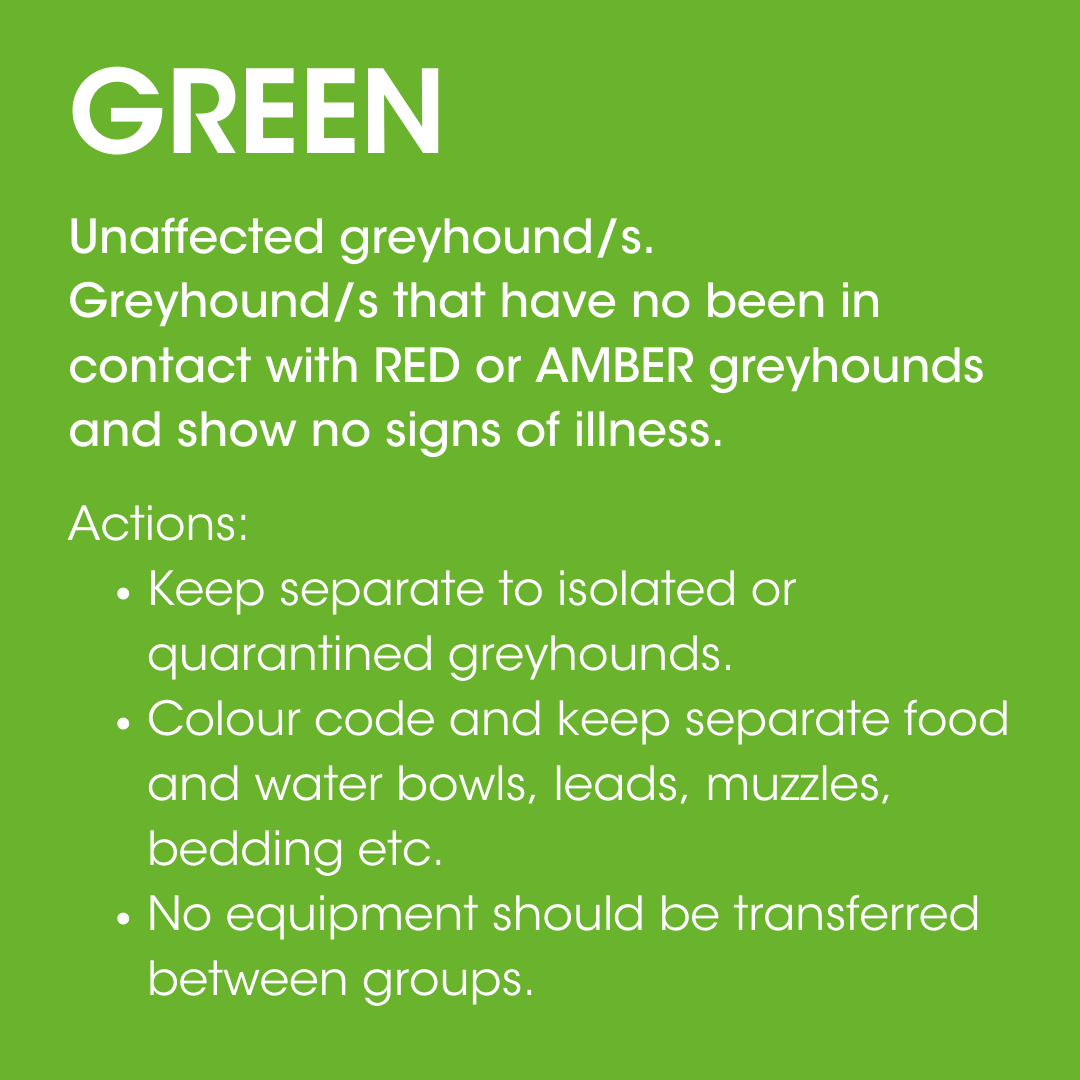Biosecurity and Hygiene
Biosecurity is about preventing the spread of infectious diseases on your property. It involves using preventive measures to reduce the risk of infectious disease, and the spread of disease if this does occur.
Biosecurity procedures include measures such as vaccinating greyhounds, monitoring them for signs of disease, isolating any greyhound that may be affected, and cleaning and disinfection of any contaminated areas.
The importance of biosecurity
An outbreak of an infectious disease in the greyhound population can have serious consequences, not just for the greyhounds that are ill but for the trainers and the industry.
In greyhound kennels, the most common infectious outbreaks are Kennel Cough and gastroenteritis.
While it is rare for a greyhound to die of kennel cough or gastro, an outbreak can result in illness in a large number of greyhounds. In turn, this can lead to scratching of greyhounds and cancellation of races, resulting in loss of income. Puppies and older, retired greyhounds, are especially at risk of more serious illness and even death.
Greyhound trainers, breeders and owners have a role in almost every aspect of biosecurity including:
- Surveillance
- Isolation and quarantine
- Cleaning and disinfection
- Protection of greyhounds that may be at risk
Surveillance
Surveillance means monitoring greyhounds for signs of infectious disease. Prompt identification and response to cases of disease can help minimise transmission to other greyhounds in both your and other kennels.
Participants who keep greyhounds should have a good understanding of different infectious diseases and when to seek veterinary attention. All cases of suspected infectious disease should be confirmed by testing at a veterinarian.
If you are aware of an outbreak in your area, remain vigilant and consider monitoring your greyhounds more frequently.
Please notify GWIC of any cases of suspected infectious disease on your property.
Isolation and quarantine
Any greyhound that is infected with an infectious disease should be isolated from other greyhounds, to reduce the risk of the disease spreading.
Quarantine involves separating greyhounds that have been exposed to a contagious disease from others. Greyhounds that have been exposed to the disease may become infected themselves, so any greyhound in quarantine that starts showing symptoms should be isolated.
Greyhounds should not be removed from quarantine until the maximum incubation time (that is, the period it takes for symptoms to develop after a greyhound is infected) for the infection has passed with no symptoms. Your veterinarian can provide further advice about this.
Because many illnesses have an incubation period, you cannot always tell just by looking at an animal whether it has been infected and is incubating the disease.
Sometimes it can be useful to employ a “traffic light system” to identify which greyhounds pose a risk of infection and which are at risk of becoming infected.
Greyhounds in each of the groups (red, amber, green) should each have their own dedicated bowls, leads, muzzles and so on.
No equipment should be transferred between groups, to reduce the risk of infection spreading.
Feeding, exercising or toileting greyhounds should occur from “green” first, and finish with the red group. This reduces the risk of transmission from infected animals to healthy ones.
Cleaning and disinfection
Thorough cleaning of organic debris (faeces, urine and other secretions) before disinfecting the entire facility and all equipment is essential. Your veterinarian will be able to advise you on the best products to use for disinfection. Following the exact instruction on the label is essential to the correct application of disinfectants.
Protecting at risk animals
To minimise risk within your property:
- Avoid contaminated areas, or putting healthy greyhounds in kennels where you know sick greyhounds have been. These areas need to be thoroughly cleaned and disinfected before being used again.
- Wear protective clothing when working with affected greyhounds, prevent unnecessary contact between greyhounds and handlers.
- Use disinfectant sprays on shoes or clothing that has come in contact with affected greyhounds.
- People handling affected greyhounds should avoid contact with unaffected greyhounds. If you do need to handle both healthy and sick greyhounds, handle the healthy ones first.
- To minimise the risk of infection coming onto or off your property:
- Limit and quarantine all new arrivals to your kennels for at least 10 days
- Avoid moving sick greyhounds off your property unless it’s absolutely necessary
- Scratch affected greyhounds as well as greyhounds that have been exposed to the infection from races. This will minimise the risk of them spreading infection at tracks
- Vehicles and shoes are a common means of transmitting infectious disease. Ensure that you remove visible organic material before disinfecting. You can also spray your tyres with disinfection agents, such as F10.
- Avoid all unnecessary movements of people and greyhounds onto and off your property during disease outbreaks.
 |  |  |